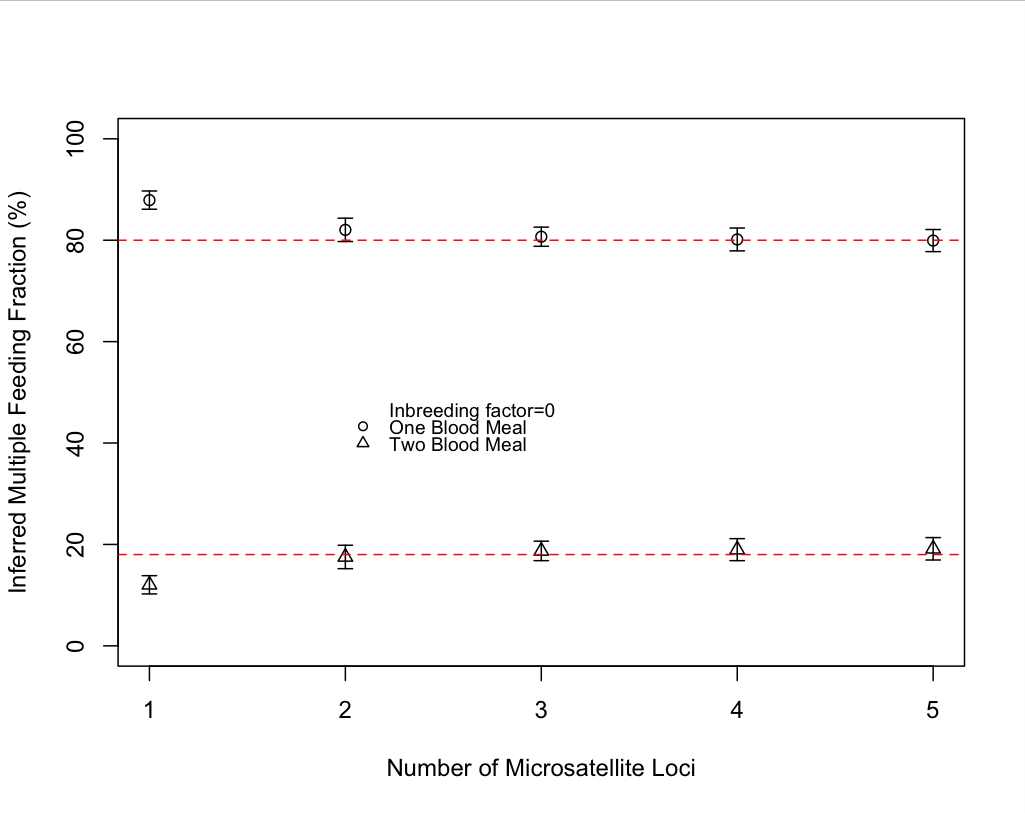Power of Locus Number Analyzed
Depending on the number of microsatellite loci analyzed, how does the resulting multiple blood meal probability vary?
In the previous section, the lower bound method yielded resulting multiple blood-meal probabilities that are very close to their theoretical numbers. It implies that four loci are sufficient to predict probabilities.
However, new methodology was built up to answer this question. The results were obtained under a Hardy-Weinberg equilibrium assumption for the human population. While human population was created based on the allele frequencies of last generation, we also assume Hardy Weinberg equilibrium (no inbreeding effect) and assume each human individual is equally likely to contribute to a blood meal. This time the theoretical multiple blood meal probabilities were set up to be 80% one blood meal, 18% two blood meals, and 2% three blood meals so that a small proportion of simulated mosquitoes are allowed to have three blood meals. Then certain numbers of loci with characteristics were randomly selected from each of four experimental loci (TPOX, D13, PK211 and CSF) with replacement and those selected loci with characteristics inherit allele frequencies from experimental loci. In this experiment, one, two, three, four, and five loci were randomly selected and the means and standard deviations of 100 resulting multiple blood meal probabilities were calculated for each set.
Graph 3: Trend of multiple blood meal probabilities by the number of microsatellite loci under Hardy Weinberg equilibrium.

Table 1: Comparisons of the resulting multiple blood meal probabilities by locus number analyzed. Human population = 1000, Mosquito population = 324 inbreeding factor = 0, Multiple Bite Distribution: 80% 1 blood meal, 18% 2 blood meals and 2 %, 3 blood meals| Number of blood meal=1 | Number of Locus: 1 | 87.91% ± 1.80 % |
| Number of Locus: 2 | 82.04% ± 2.30 % |
| Number of Locus: 3 | 80.69% ± 1.89 % |
| Number of Locus: 4 | 80.15% ± 2.25 % |
| Number of Locus: 5 | 79.93% ± 2.18 % |
| Number of blood meal=2 | Number of Locus: 1 | 12.04% ± 1.80 % |
| Number of Locus: 2 | 17.53% ± 2.31% |
| Number of Locus: 3 | 18.72% ±1.92 % |
| Number of Locus: 4 | 18.97% ± 2.17% |
| Number of Locus: 5 | 19.14% ± 2.21 % |
As expected, the numbers of resulting multiple blood meals estimated from lower bound method converge to the theoretical numbers (80% one blood meal, 18% two blood meals) as the number of loci increases. Under Hardy Weinberg equilibrium, three loci already give a good result (80.69% for one blood meals). Therefore, four loci are even more robust because if a PCR product is undetectable in the electrophoresis, analyzing 3 loci still gives good statistics. Choosing one more locus than the minimum is best because some samples do not yield the full complement of loci due to PCR problems. We now consider the influence of detection on the lower bound method.

